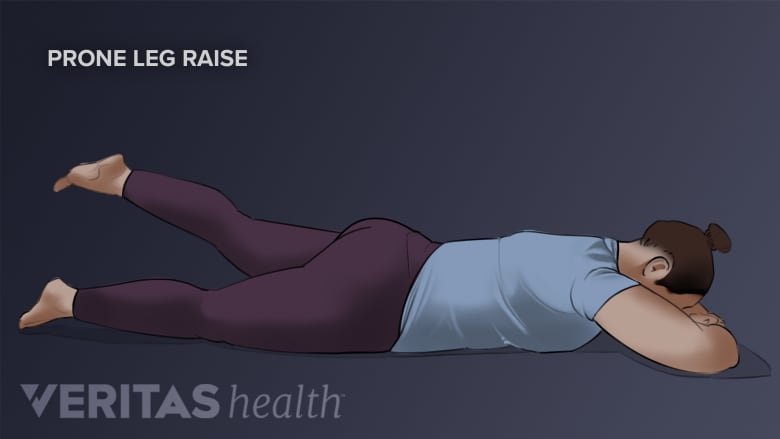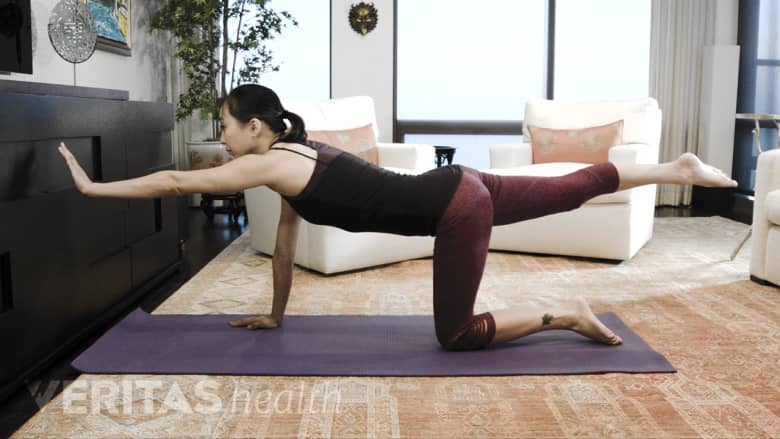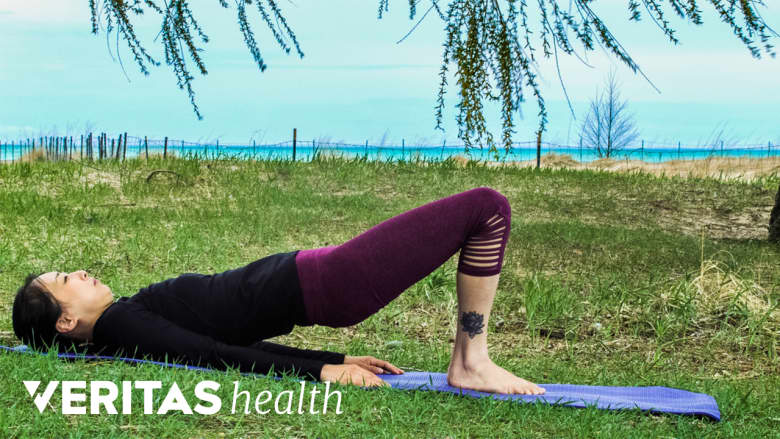Therapeutic exercises to treat aging-related degeneration of a lumbar disc focus on relieving the deep ache in the lower back and reducing sciatic leg pain caused by compressed spinal nerves.
Exercises to relieve lumbar degenerative disc disease pain aim to:
- Strengthen the deep muscles of the spine and reduce spinal instability caused by the reduced disc space1Paul CPL, Emanuel KS, Kingma I, et al. Changes in Intervertebral Disk Mechanical Behavior During Early Degeneration. Journal of Biomechanical Engineering. 2018;140(9):91008. doi:10.1115/1.4039890,2Kim S, Kim H, Chung J. Effects of Spinal Stabilization Exercise on the Cross-sectional Areas of the Lumbar Multifidus and Psoas Major Muscles, Pain Intensity, and Lumbar Muscle Strength of Patients with Degenerative Disc Disease. J Phys Ther Sci. 2014;26(4):579–582. doi:10.1589/jpts.26.579
- Relieve nerve root compression due to degenerative changes, such as osteophytes (bone spurs)3Saleem S, Aslam HM, Rehmani MA, Raees A, Alvi AA, Ashraf J. Lumbar disc degenerative disease: disc degeneration symptoms and magnetic resonance image findings. Asian Spine J. 2013;7(4):322–334. doi:10.4184/asj.2013.7.4.322
- Improve posture through specific stretching techniques in the lower back and legs
Structures in the lumbar, abdominal, pelvic, and thigh regions are worked on as a group to build overall strength and endurance.
In This Article:
- Sciatica Exercises for Sciatica Pain Relief
- Exercise for Sciatica from a Herniated Disc
- Exercise for Sciatica from Spinal Stenosis
- Exercise for Sciatica from Degenerative Disc Disease
- Exercise for Sciatica from Isthmic Spondylolisthesis
Sciatica Exercises for Degenerative Disc Disease
Sciatica from degenerative disc disease is commonly treated using exercises from a dynamic lumbar stabilization program. Exercises from these programs include finding the most comfortable position for the lumbar spine and pelvis and training the body to maintain this position during daily activities. Doing so can:
- Improve the proprioception (sense of movement) of the lumbar spine
- Strengthen the lower back muscles to reduce excess motion at a spinal segment
The exercises help stabilize the lumbar spine by working out the core muscles and preventing further loss of muscle mass. Excessive movement between adjacent vertebral segments is also reduced, decreasing the amount of irritation at the vertebral segment, relieving pain, and protecting the area from further damage.
Exercises to Strengthen the Lower Back Muscles
The following exercises target the lower back—strengthening the superficial and deep muscles of the lumbar spine.
Prone leg lifts

Prone leg lifts strengthen the lower back and core muscles, reducing the risk of back injuries.
Start by lying flat on the stomach.
- Tuck both hands tucked to the side of the body.
- Raise one leg upward with the knee slightly bent and without arching the back or neck.
Hold for 4 to 6 seconds and slowly lower to the starting position. Repeat with the other leg. Aim to complete 4 to 6 repetitions of this exercise.
Prone arm and leg lifts
Start by lying flat on the stomach.
- With the elbows straight, stretch both arms above the head.
- Raise one arm and the opposite leg 2 to 3 inches off the floor.
Hold for 4 to 6 seconds and slowly lower to the starting position. Repeat with the opposite arm and leg. Aim to complete 4 to 6 repetitions of this exercise.
4-point leg lifts
Start in a 4-point position, with hands and knees on the floor.
- Position the hands directly under shoulders and knees directly under hips.
- Look down at the floor without bending the neck.
- Raise one leg behind with the knee slightly bent. Do not arch the back or neck.
Hold for 4 to 6 seconds and slowly lower to the starting position. Repeat with the other leg. Aim to complete 4 to 6 repetitions of this exercise.
Bird dog exercise

Bird dog exercise strengthens the core and stabilizes the lower back.
Start in a 4-point position similar to the previous exercise.
- Raise one leg with the knee slightly bent.
- Simultaneously, raise the opposite arm. Do not arch in the back or neck.
Hold for 4 to 6 seconds and slowly lower to the starting position. Aim to complete 4 to 6 repetitions of this exercise.
See Back Strengthening Exercises
As strength builds, aim to complete 10 leg (and arm) raises for each type of exercise twice daily. For exercises involving arm and leg lifts, raise the arms and legs only as high as can be controlled and is comfortable.
Exercises to Strengthen the Abdominal Muscles
Examples of exercises that build strength in the abdominal muscles to develop a stronger and more stabilized core are discussed below.
Hook-lying march

The hook lying march exercise targets the core, glutes, and hip muscles.
Start by lying on the back.
- Tucked both arms to the side and hold a pelvic tilt.
- Slowly raise alternate legs 3 to 4 inches from the floor (similar to a marching motion).
Aim to march for 30 seconds. Repeat for 1 or 2 more sets, with 30-second breaks in between repetitions.
For an advanced variation of this exercise, raise and lower the opposite arm over the head while marching.
Bridge

The bridge exercise targets the core and gluteal muscles.
Start by lying on the back
- Bend both knees bent and tuck the arms at the side.
- Slowly raise the buttocks from the floor. Aim to align the back in a straight line from the shoulder to the pelvis.
Hold the bridge for 8 to 10 seconds and slowly lower to the starting position. As strength builds, aim to complete 2 sets of 10 bridges.
These exercises must be performed with a rigid trunk, without bending or sagging the spine.
If pain or discomfort is felt at any point while performing these exercises, it is recommended to stop and seek medical attention. It is helpful to learn these exercises from a trained medical professional to follow the correct technique and tailor the intensity or technique to suit individual needs.
- 1 Paul CPL, Emanuel KS, Kingma I, et al. Changes in Intervertebral Disk Mechanical Behavior During Early Degeneration. Journal of Biomechanical Engineering. 2018;140(9):91008. doi:10.1115/1.4039890
- 2 Kim S, Kim H, Chung J. Effects of Spinal Stabilization Exercise on the Cross-sectional Areas of the Lumbar Multifidus and Psoas Major Muscles, Pain Intensity, and Lumbar Muscle Strength of Patients with Degenerative Disc Disease. J Phys Ther Sci. 2014;26(4):579–582. doi:10.1589/jpts.26.579
- 3 Saleem S, Aslam HM, Rehmani MA, Raees A, Alvi AA, Ashraf J. Lumbar disc degenerative disease: disc degeneration symptoms and magnetic resonance image findings. Asian Spine J. 2013;7(4):322–334. doi:10.4184/asj.2013.7.4.322
Editor’s Top Picks

